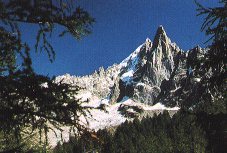The mountains of the Earth
a fragile environment in great danger,
resources and tourism in a delicate ecosystem
by Vincenzo Di Dato
bioarchitect for Ecosportello
Valle d'Aosta Region, Italy
There are many matters at stake for the mountains and their future. In fact, life in the mountains has always been hard and, with the advent of affluence, as in the case of the Alps, it is difficult to find a balance. At present, the planet's mountains are experiencing contradictory situations; on the one hand, like in the Alps, there has been a very sudden economic boom which started in the 1960s.
On the other hand, like in the Andes or Tibet, life is still very precarious and difficult. At the same time, new "tourist paradises" are springing up in the Himalayas or in the Valley of the Eagles in Mongolia. As in other cases, we find ourselves in a system in which there are incoming and outgoing flows, besides a cycle of internal resources.
When this system is balanced, these flows are extensively embraced by the ecological (and therefore economic) system of the mountains. When the balance is tipped, the consequences are both ecological and economic: the loss is evident also in terms of financial cost, both short and long term, since the main resource, the environment, has been damaged.
Culture and environment are closely interconnected, as proved by the fact that the best safeguarding also provides for the survival of the traditional activities which maintain the mountains.
The AlpsThe UN's Sustainable Development Commission, in the framework of Agenda XXI, chp. 13, published a "Charter for sustainable mountain development" in 1995. Essentially, it makes the point that the safeguarding of the mountains is closely correlated to the problems linked to climate: the gradual disappearance of the glaciers, and the greenhouse effect. In fact, the Earth's mountains represent a particularly fragile and vulnerable environment.
Therefore, it is necessary to adopt effective preventive measures to combat environmental decay. However, the vast majority of this programme has still not been applied and now a new race has begun for possession of the curative plant resources by the big pharmaceutical industries.
In the Himalayas alone there are 400 kinds of medicinal plants used by traditional medicine which are very tempting for western industries. The mountains represent a varied and important resource: from an energy point of view there is enormous potential regarding renewable, clean energies such as those available from the sun, water, wind and biomasses.
Furthermore, it is important to note that in the lesser-developed areas the mountains are run by the women who represent the real driving force of survival and the economy. To alter (even with constructive interventions) this reality means running the risk of losing a heritage of culture and precious wisdom.
See also:
|
|

